Chewy Sea Salt Caramels infused with ROSEMARY! Because salted caramels are great, but herb-infused caramels are better. Finish with sea salt to create the ultimate sea salt caramel.
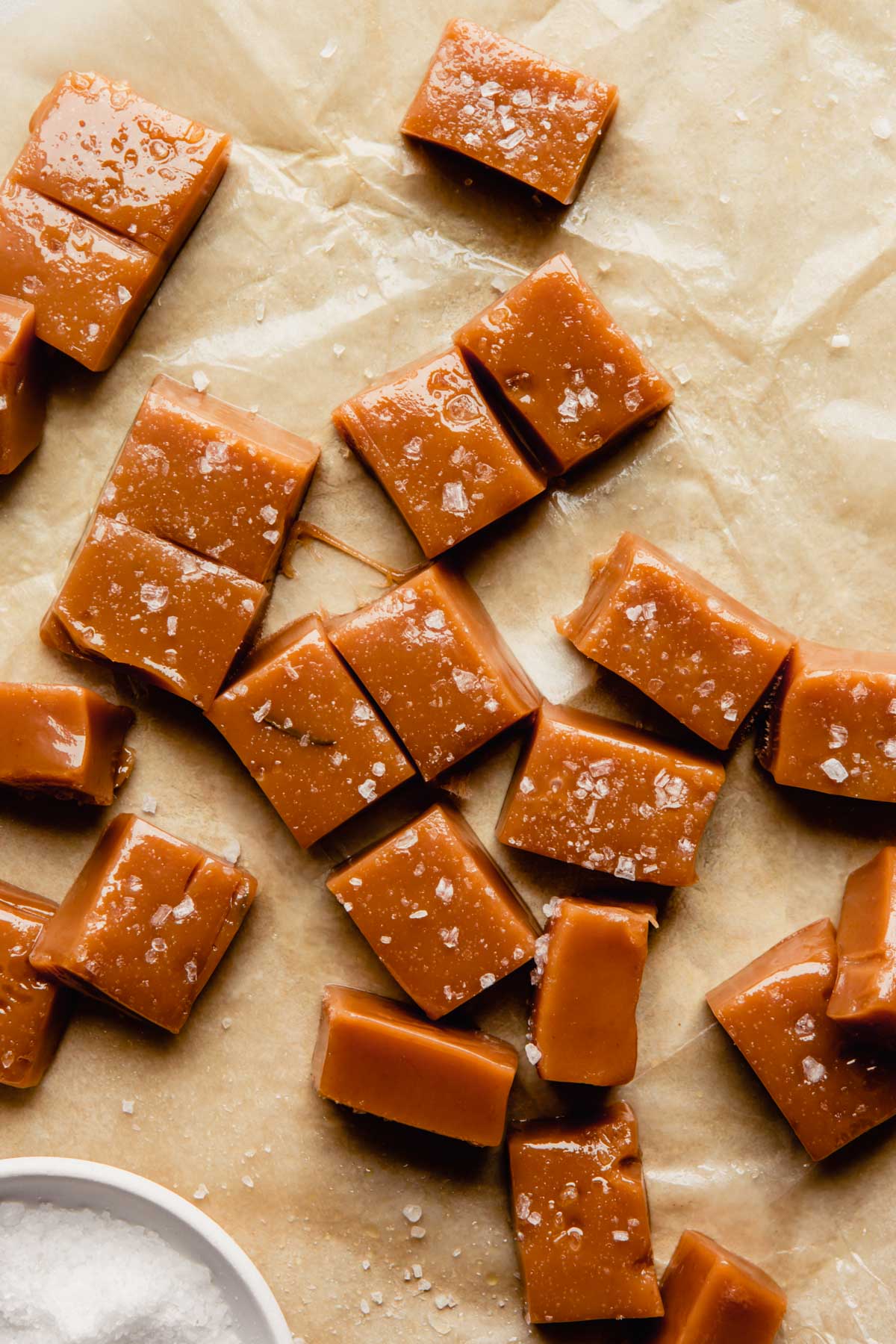
Tips for Making Homemade Caramels
Use a candy thermometer. Without a candy thermometer, making these dark chocolate sea salt caramels at home will be more than challenging.
Be prepared. Most of the action happens within 30 seconds when making caramel. It’s important to move fast and efficiently. The temperature of sugar can rise rapidly; just a few extra seconds over heat, or a delay in adding butter can drastically change the product.
Use a combination of sugars. It’s important to use a combination of sugar types when making caramel (sucrose, fructose, glucose). More type of sugar = variety of molecule shapes.
When one type of sugar is used, the molecules nestle together during cooling, creating gritty, crumbly crystals. Using a combination of sugars means the sugar molecules won’t crystalize as easily, resulting in a caramel that’s silky and smooth.
Use heavy whipping cream. Avoid using cream that’s simply labeled “whipping cream” as it might have a lower percentage of fat. For this recipe, your cream should have a minimum of 36% fat content.
Watch How to Make Sea Salt Caramels:
[adthrive-in-post-video-player video-id=”poHjQIuR” upload-date=”2021-09-15T21:09:00.000Z” name=”Rosemary Sea Salt Caramels” description=”homemade caramel, homemade candy, candy making, holiday gift, holidays” player-type=”collapse” override-embed=”false”]Prevent crystallization
When making homemade caramel, it’s important to avoid crystallization. Crystallization is the opposite of everything we love about soft, chewy caramels. When sugar crystalizes it creates a grainy texture in the finished product.
When adding the granulated sugar to the pan, before you even begin cooking, it’s important to avoid getting any granules on the sides of the pans. To avoid this, slowly pour the sugar in the center of the pan.
During the first stage of cooking, if you see any crystallization start to form on the sides of the pan, carefully brush the sides of the pan with some water using a pastry brush.
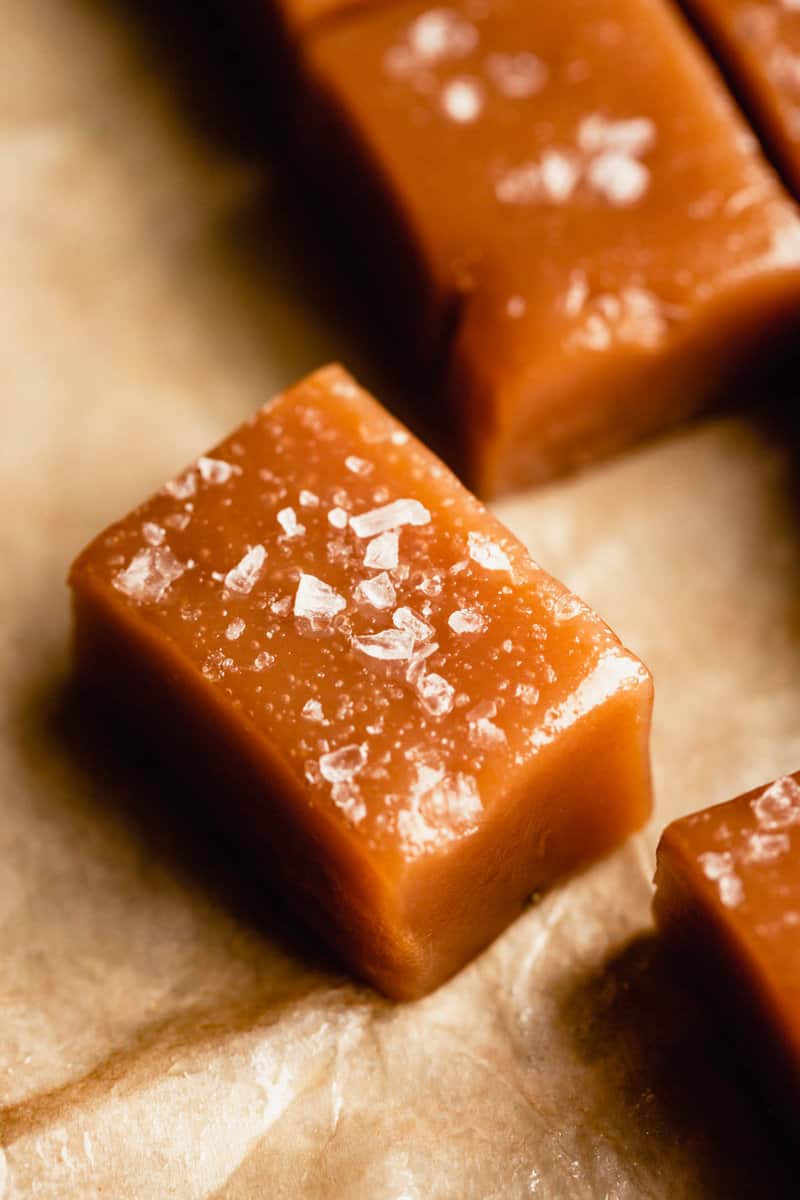
Use a Thermometer
First and foremost, you WILL need a candy thermometer or instant-read thermometer for these sea salt caramels. Unless you can make caramels purely off of intuition (in that case you probably don’t need to be here), then you need a thermometer.
Temperature is absolutely key to achieving successful caramels. For candy making, I like to use a candy thermometer. They have a handy clip that allows you to clip the thermometer right to the side of the pan (nice for avoiding a steam-induced burn). Candy thermometers also usually feature a guard to keep the probe of the thermometer from touching the bottom of the pan.
If your candy thermometer doesn’t have a guard, just be sure to not let the probe touch the bottom of the pan.
How to calibrate a thermometer: Test your thermometer by taking the temperature of boiling water—it should read 212°F. Adjust the recipe temperature up or down based on your test.
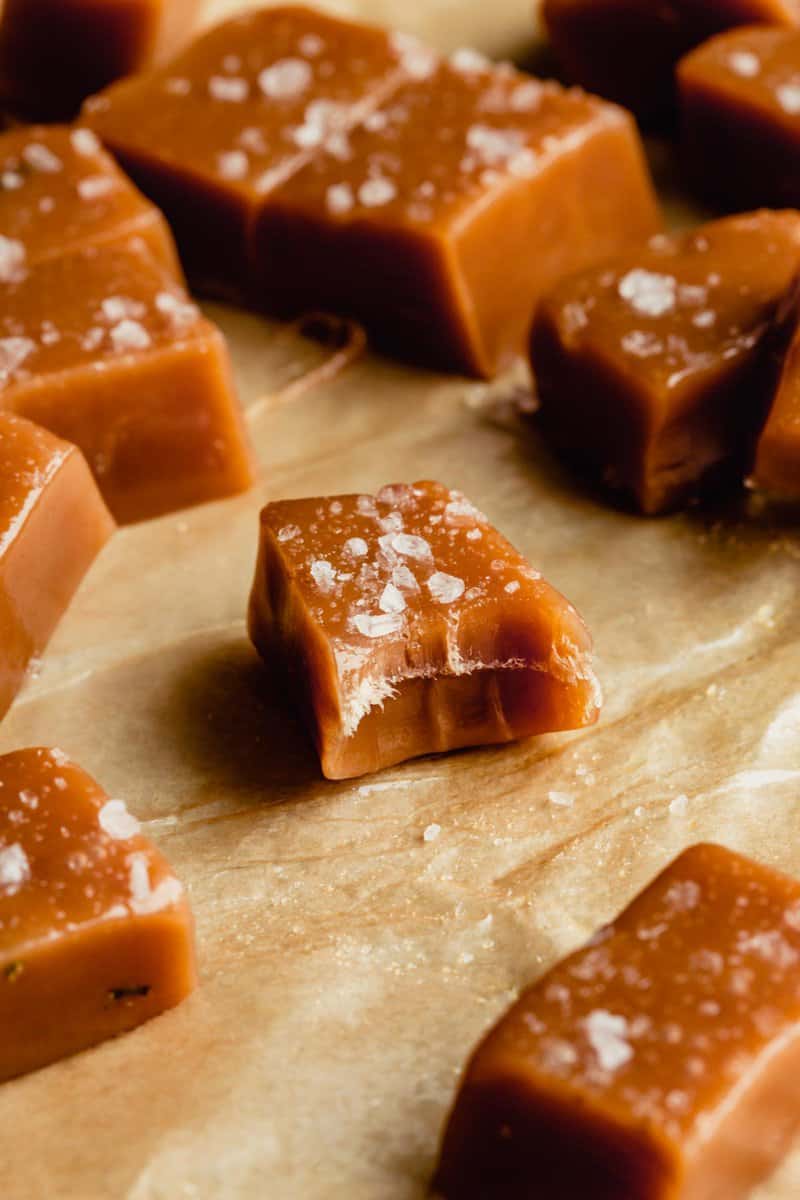
Making Caramel is All About Temperature
This sea salt caramel recipe has two important temperatures to keep in mind.
As a quick reference, the sugar syrup will first be cooked to 320ºF (160ºC) to 325ºF (163ºC).
Then, secondly, the caramel mixture will be cooked to 240°F (115ºC) to 245ºF (118ºC).
This two-step process is important for achieving deep flavor and adequate texture. The first temperature, 320ºF (160ºC), cooks the sugar syrup past hard-crack stage (think hard sugar candies like brittles and poured suckers), and into the caramel stage.
At this stage, nearly all of the moisture from the mixture has evaporated out and the sugar is now browning and becoming caramel. True caramel, kept in this original state, is used to make brittles, pralines, and nougatine.
The second step of this process is adding fat and moisture to the caramel mixture, and cooking it to a much lower temperature, 240°F (115ºC), to create a soft and chewy caramel.
If you like softer caramels, cook the caramel in the second stage to 240°F (115ºC).
If you’re like me and prefer a chewier caramel, cook the caramel in the second stage to 245ºF (118ºC).
Swirling vs Stirring
Homemade caramel may seem finicky, but I’m here to tell you, if you follow the recipe you’ll find that homemade caramel is actually quite simple. One thing to keep in mind—don’t stir unless the recipe tells you to stir!
It might not seem like a big deal—but when it comes to caramel it is! During the first stage of cooking there’s no need to stir. Let the mixture bubble away, uninterrupted, until the sides of the pan start to turn amber brown. Once browning starts to occur, even the slightest, you can give the pan a little swirl.
You can stir the mixture in the second stage of cooking, when the cream and butter mixture has been added.
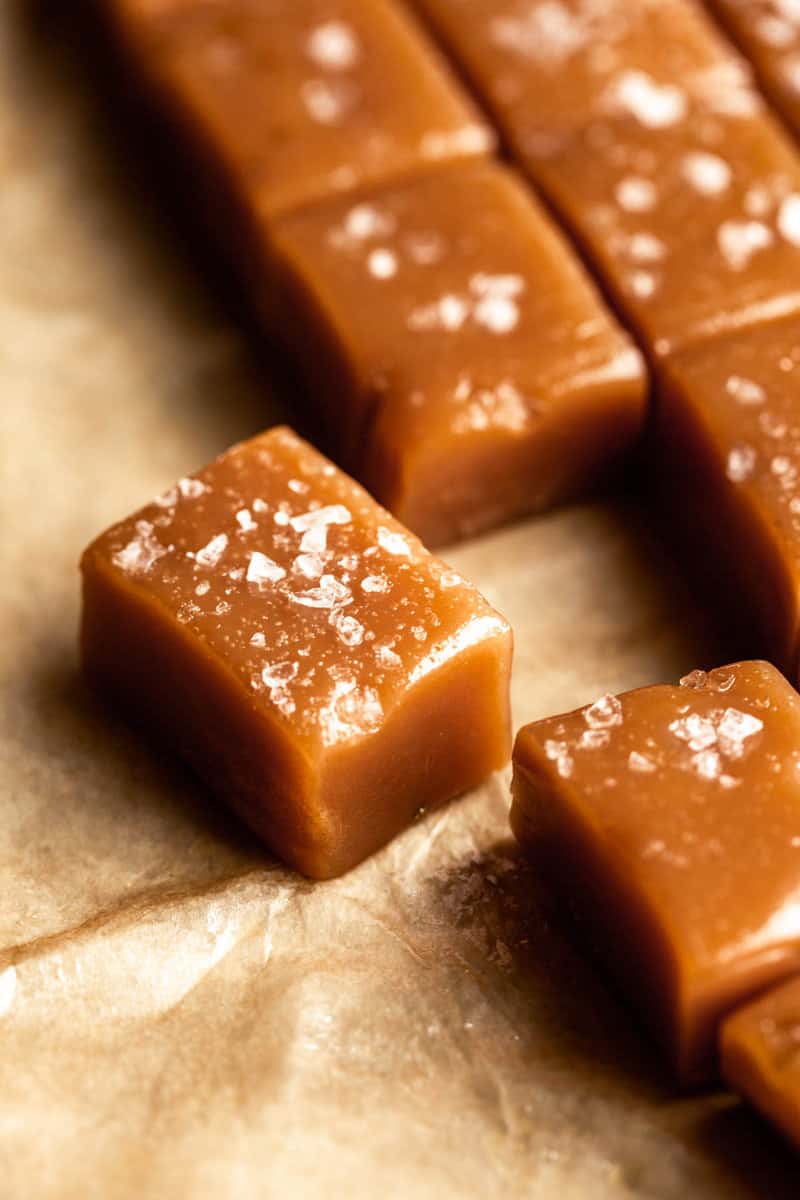
How to Clean the Sticky Pan
Cleaning hardened caramel out of a pan can be a big pain in the rear. For easier clean up, fill the saucepan with water and bring to a boil. Watch the caramel melt away! Add the candy thermometer, rubber spatula and/or wooden spoon to the pot if they also have stuck on caramel.
Variations on this sea salt caramel recipe:
- Instead of infusing the cream with rosemary, add the seeds of one vanilla bean.
- Swap the rosemary sprig for a few peels of orange zest.
- Drizzle each caramel with dark chocolate.
More Candy Recipes to Try
- Try our Old-Fashioned Peanut Brittle for a nostalgic throwback. It’s crisp and crunchy, nutty, sweet and salty. All the things!
- Chocolate and caramel become one in these Dark Chocolate Sea Salt Caramels. The best of both worlds!
- Dark Chocolate Truffles are an elegant treat for Christmas for Valentine’s Day. They also make a great food gift! We also have Vegan Dark Chocolate Truffles if you need them to be dairy-free!
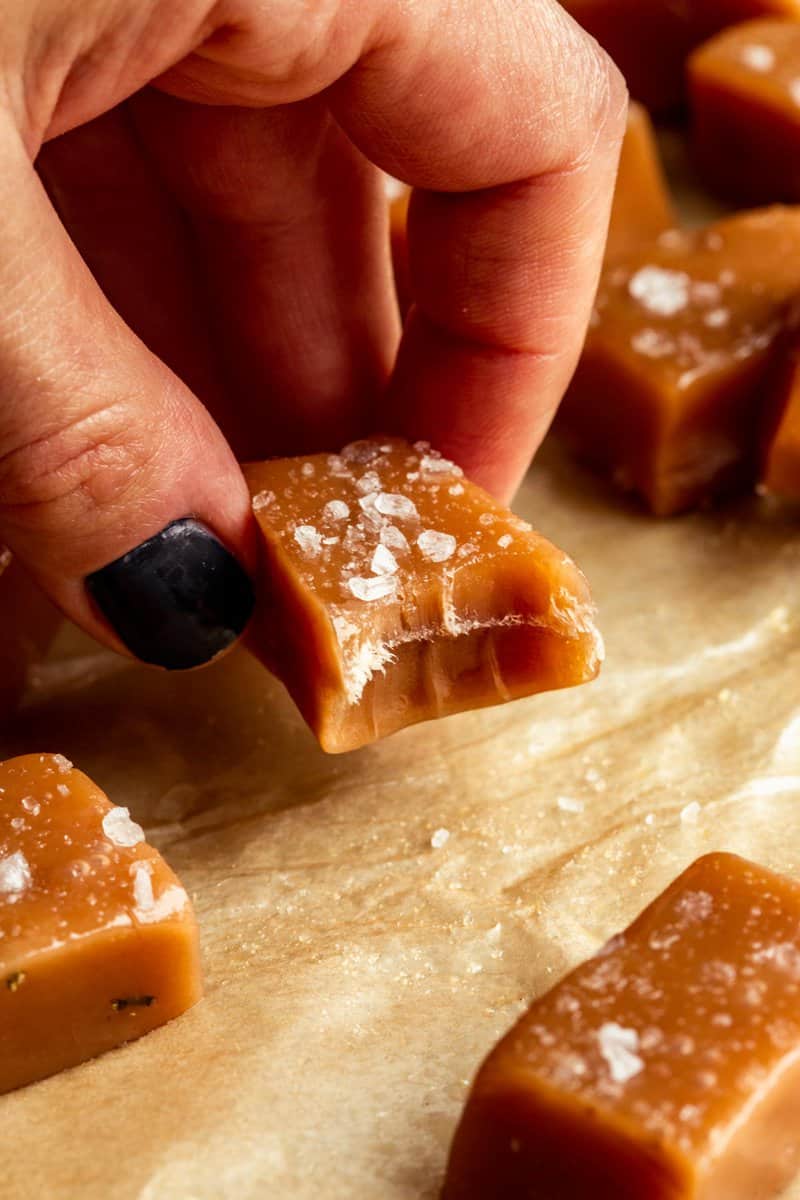
Make sure to tag me @ZESTFULKITCHEN ON INSTAGRAM or tag #zestfulkitchen on social media if you make a recipe!
Don’t forget, if you make these salted caramels leave a comment and rating below!
Pin this recipe and save it for later by clicking the button on any photo. You can also click the red button on the bar below the recipe. Happy candy making!
Print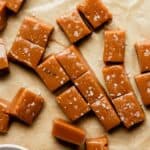
Chewy Rosemary Sea Salt Caramels
- Prep Time: 5 minutes
- Cook Time: 30 minutes + 2 hours cooling time
- Total Time: 35 minutes + 2 hours cooling time
- Yield: 24 caramels 1x
- Category: Dessert
- Method: Stove top
- Cuisine: American
- Diet: Gluten Free
Description
Chewy homemade caramels infused with rosemary and finished with crunchy sea salt. An explosion of flavor in every bite!
Ingredients
- 3 tablespoons water
- ¼ cup light corn syrup
- 1 cup granulated sugar
- ½ cup unsalted butter (8 tablespoons)
- ½ cup heavy cream*
- 1 large rosemary sprig
- ¼ teaspoon coarse sea salt + more for sprinkling (such as fleur de sel or Maldon)
Instructions
- Line a 5×8-inch loaf pan with parchment paper; grease parchment.
- Bring butter, cream. and rosemary to boil. Remove from heat and stir in ¼ teaspoon salt; let cool.
- Combine water, corn syrup and sugar with a wooden spoon or heat-proof rubber spatula in a large saucepan. Stir until sugar is saturated with water.
- Bring sugar solution to a boil over medium-high heat, and cook, without stirring, until sugar has dissolved and temperature reaches 300°F (149ºC), about 10 minutes. Reduce heat to medium and simmer, gently swirling pan, until edges of mixture start to turn a light amber and temperature reaches 320ºF (160ºC) to 325ºF (163ºC), about 5 minutes.
- Once 320ºF (160ºC) is reached, remove from heat. Remove and discard rosemary sprig from cream mixture; carefully pour a quarter of the cream mixture into sugar syrup and swirl to incorporate. (Be careful, mixture will bubble up.)
- Add remaining cream and butter mixture and stir to incorporate. Return pan to medium-high heat and cook, stirring frequently, until caramel reaches 240°F (115ºC) for softer caramels or 245ºF (118ºC) for chewier caramels, 5–10 minutes.
- Carefully pour caramel into prepared pan; allow caramel to cool for 20 minutes at room temperature, then sprinkle with ½–1 teaspoon sea salt and let cool until completely solid and cold to touch, 1–2 hours.
- Pull edges of parchment paper to release caramel from pan. Cut caramel into ¾-inch-wide strips and then crosswise into 1-inch pieces. Individually wrap pieces in waxed-paper squares, twisting ends of paper to close.
- Caramels can be refrigerated for up to 3 weeks.
Notes
Be sure to use heavy cream or heavy whipping cream. Avoid using cream that’s simply labeled “whipping cream” as it might have a lower percentage of fat. For this recipe, your cream should have a minimum of 36% fat content.
Humidity can impact caramel making—I’ve found cool dry days result in the best caramels.
Keywords: sea salt caramels, salted caramels
This recipe was originally posted on March 2, 2015.
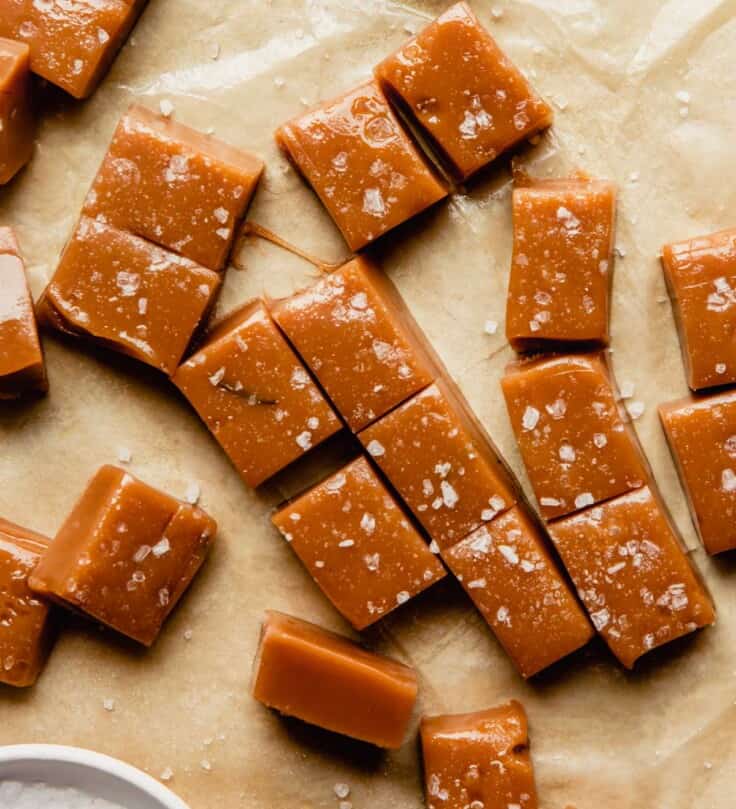





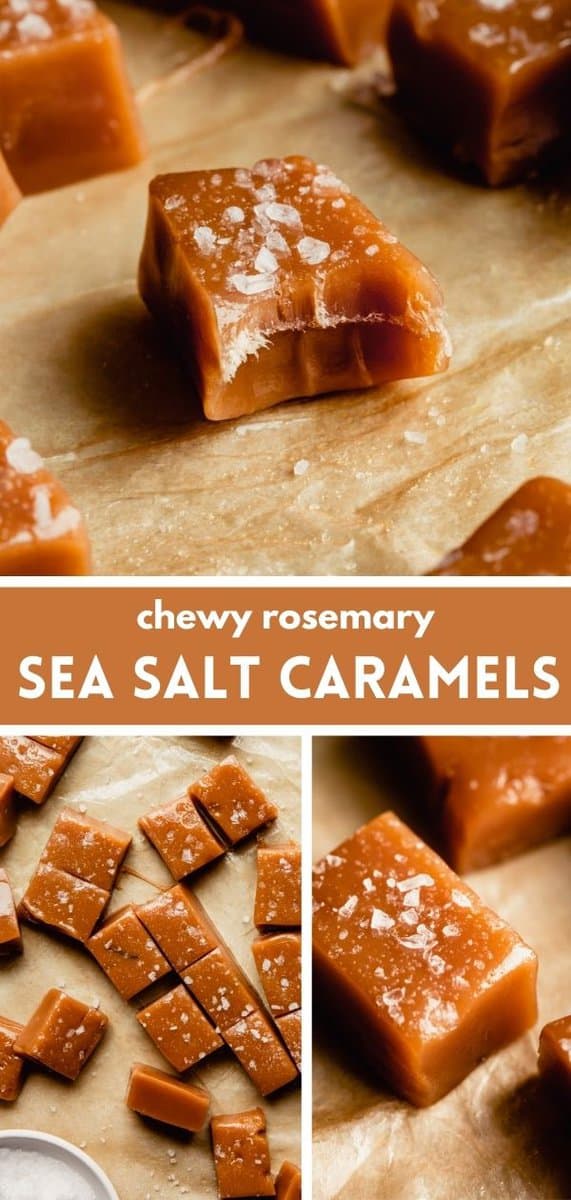
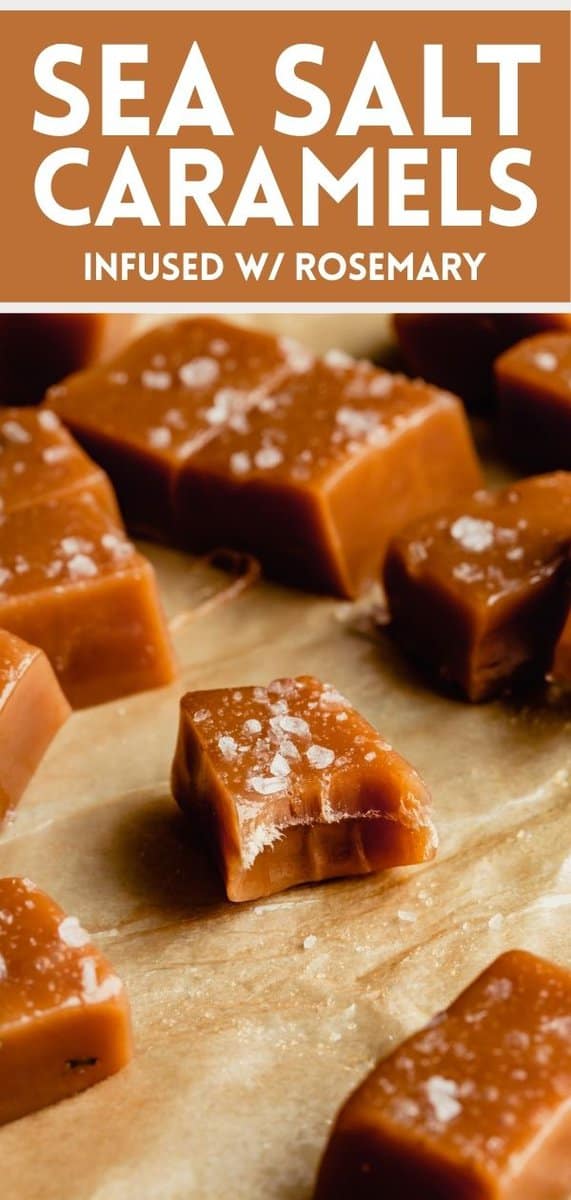
Holy heck are these delicious! You can really taste the rosemary in the final product. I subbed honey for the corn syrup because I didn’t want to go buy corn syrup, but I was extra careful about crystals and they turned out just wonderful!!!
★★★★★
I LOVE hearing that honey worked well in these, I’ve been wanting to test these with honey! SO happy you enjoyed them!
Can these only be stored in the refrigerator? If so, how long are they good for outside of the refrigerator?
Hey Nikki! Great question, you can definitely leave these out at room temp. They should keep for 2 weeks. Let me know how it goes! These are my favorite.
Hello Lauren
Thanks for the info. I made them for the first time and I don’t know what I did wrong but it came out like hard candy instead of chewy. Also the part when mixing in the butter, it did not full incorporate. I still had butter separating from the carmal. I even ended up doubling the sugar mixture trying to get the butter to mix in but that didn’t help much. All in all flavor, and color was there. Very yummy. What did I do wrong you think?
Hi Nikki, gosh first of all I don’t know how I missed this comment. I’m so sorry for my delay! From your notes I assume the sugar mixture was too hot, or it was still over the heat when the butter and milk mixture were added. It’s important to remove the pan from heat before adding the milk/butter mixture. High heat will cause the butter to separate from the rest of the caramel mixture. (When the milk/butter mixture were being heated separately from the sugar mixture, did it ever come to a boil? If so, this could also be part of the problem.) The addition of more sugar caused the ratio between sugar and fat to be off balance, which is partially why the candies came out hard (in addition to longer cooking, I assume).
Homemade caramel is challenging, in addition to temperature it’s also very much about visual appearance. I highly recommend using a thermometer, this will take a lot of the guesswork out of the process. Here to help (I will keep a better eye on the comments) if you need!
When the recipe says use different types of sugar are you referring to brown and white sugar or white sugar and cornsyrup
Great question! In the article I’m referring to white sugar and corn syrup. The goal is to use types of sugar as they have different molecular shapes. You won’t need brown sugar for this recipe.
These are so tasty! These rosemary infused sea salt caramels will be a must for our Christmas from this year on. My husband and I love them and they are very easy to make too! We prefer cooking to the 245 for a chewier caramel.
Thanks for sharing!
★★★★★